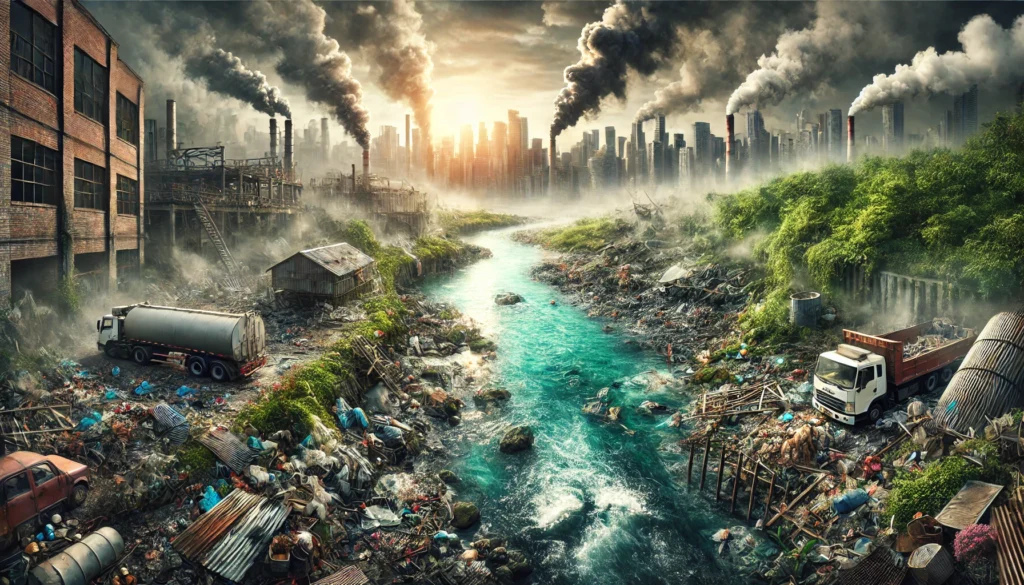Hey there, fellow Earthlings! Today, we’re diving deep into a topic that’s been making waves (pun intended) for decades: pollution. You know, that pesky problem that’s been crashing our planet’s party like an uninvited guest who refuses to leave. So, grab your hazmat suits, and let’s embark on a not-so-clean journey through the murky waters, hazy skies, and contaminated soils of our beloved Earth.
The Dirty Truth: An Overview of Pollution
What’s the big stink about pollution?
Pollution, my friends, is like that one relative who shows up at family gatherings and manages to ruin everything. It’s the ultimate party pooper, affecting our water, air, and soil in ways that would make even the toughest environmental warrior weep. But before we start pointing fingers at this environmental menace, let’s break it down and see what we’re really dealing with.
Pollution occurs when harmful substances or contaminants are introduced into the environment, causing adverse effects on living organisms and ecosystems. It’s like dumping a bunch of hot sauce into your grandmother’s famous apple pie recipe – it just doesn’t belong there, and it’s going to cause some serious problems. These pollutants can come from various sources, both natural and human-made, but let’s be honest, we humans have been doing a bang-up job of accelerating the process.
Now, you might be thinking, “Surely, it can’t be that bad, right?” Well, buckle up, buttercup, because we’re about to take a wild ride through the not-so-wonderful world of pollution. From contaminated water sources to smog-filled skies and toxic soils, we’ll explore how pollution is affecting our planet and what we can do to kick this unwelcome guest to the curb.
Water Pollution: When H2O Becomes H2-Oh No!
Making waves for all the wrong reasons
Water, water everywhere, but not a drop to drink – especially when it’s polluted! Water pollution occurs when harmful substances contaminate our water bodies, making them unsafe for both humans and aquatic life. It’s like someone decided to turn our pristine lakes, rivers, and oceans into a giant, toxic soup. Yum!
Let’s dive into some of the major culprits behind water pollution:
- Industrial waste: Factories and industrial facilities often discharge their waste directly into water bodies, turning them into chemical cocktails that would make even the bravest fish think twice about taking a swim.
- Agricultural runoff: Pesticides, fertilizers, and animal waste from farms can wash into nearby water sources, creating a toxic buffet for aquatic life.
- Sewage and wastewater: When our waste management systems fail or are overwhelmed, untreated sewage can end up in our water bodies, bringing a whole host of nasty bacteria and pathogens along for the ride.
- Oil spills: These environmental disasters can have long-lasting effects on marine ecosystems, turning crystal-clear waters into black, gooey messes.
- Plastic pollution: Our love affair with plastic has led to massive amounts of this non-biodegradable material ending up in our oceans, creating floating garbage patches that would make even the most hardcore hoarder blush.
Now, let’s take a look at some eye-opening statistics on water pollution:
| Fact | Statistic |
|---|---|
| Amount of plastic entering the ocean annually | 8 million metric tons |
| Percentage of the world’s population without access to safe drinking water | 29% |
| Number of people who die each year from diseases related to unsafe water | 3.4 million |
| Percentage of rivers and streams in the US considered “impaired” | 46% |
| Number of chemicals found in US tap water | Over 300 |
These numbers are enough to make you want to stick to drinking nothing but bottled water for the rest of your life – but wait! That would only contribute to more plastic pollution. It’s a catch-22 that would make Joseph Heller proud.
The ripple effect of water pollution
Water pollution doesn’t just affect the fish and other aquatic creatures – it has far-reaching consequences for all of us landlubbers too. Contaminated water can lead to a whole host of health problems, from gastrointestinal issues to more serious conditions like cancer and reproductive problems. It’s like playing Russian roulette every time you take a sip from the tap.
But it’s not just our health at stake. Water pollution also has significant economic impacts. It affects industries like fishing and tourism, and the costs of cleaning up polluted water bodies can be astronomical. It’s like trying to clean up after the world’s messiest roommate – expensive, time-consuming, and endlessly frustrating.
Air Pollution: When Breathing Becomes an Extreme Sport
Taking the ‘fresh’ out of fresh air
Ah, the great outdoors! There’s nothing quite like stepping outside and taking a deep breath of… smog? Air pollution has turned the simple act of breathing into a risky endeavor in many parts of the world. It’s like Mother Nature decided to hotbox the entire planet, and we’re all stuck inside without proper ventilation.
Let’s clear the air (pun intended) on some of the main sources of air pollution:
- Vehicle emissions: Our love affair with cars has turned our cities into giant exhaust pipes, pumping out a cocktail of pollutants that would make even the hardiest lungs wheeze.
- Industrial processes: Factories and power plants are like the chain-smokers of the industrial world, constantly puffing out harmful gases and particulate matter.
- Agricultural activities: From livestock emissions to the burning of crop residues, agriculture is serving up a not-so-appetizing menu of air pollutants.
- Household activities: Surprise! Even our cozy homes contribute to air pollution through the use of certain cleaning products, paints, and cooking fuels.
- Natural sources: Mother Nature herself isn’t entirely innocent – volcanic eruptions, dust storms, and wildfires all contribute to air pollution. Talk about biting the hand that feeds you!
Now, let’s take a breath (if you dare) and look at some alarming statistics on air pollution:
| Fact | Statistic |
|---|---|
| Number of premature deaths globally due to air pollution annually | 7 million |
| Percentage of the world’s population breathing unsafe air | 92% |
| Economic cost of air pollution globally | $5 trillion per year |
| Number of cities exceeding WHO air quality guidelines | 9 out of 10 |
| Reduction in life expectancy due to air pollution in some regions | Up to 2 years |
These numbers are enough to make you want to invest in a personal bubble to live in – but let’s face it, that would probably just contribute to more plastic pollution. It’s a vicious cycle!
The domino effect of air pollution
Air pollution doesn’t just stop at making our air unbreathable – oh no, it’s an overachiever in the worst possible way. The effects of air pollution extend far beyond our respiratory systems, impacting everything from our cardiovascular health to our cognitive function. It’s like a multi-level marketing scheme of doom, affecting every aspect of our lives.
But wait, there’s more! Air pollution also plays a starring role in climate change, contributing to the greenhouse effect and global warming. It’s like the Earth decided to wrap itself in a big, polluted blanket and crank up the thermostat. And let’s not forget about acid rain, which is basically nature’s way of giving us a very unwanted shower.
The economic impacts of air pollution are equally staggering. From healthcare costs to reduced agricultural yields, air pollution is hitting us where it hurts – right in the wallet. It’s like paying for a gym membership only to have someone pump smog into the exercise room. Not exactly the return on investment we were hoping for!
Soil Pollution: When Dirt Gets Dirty
Getting down and dirty with soil contamination
Soil pollution might not be as visible as water or air pollution, but don’t let that fool you – it’s just as insidious. When harmful chemicals and contaminants find their way into our soil, it’s like giving Mother Earth a bad case of food poisoning. And trust me, you don’t want to see what happens when the planet gets the runs!
Let’s dig into some of the main culprits behind soil pollution:
- Industrial activities: Factories and industrial sites are like that messy kid in art class, spilling toxic chemicals all over the place and leaving a mess for others to clean up.
- Agricultural practices: Pesticides, herbicides, and chemical fertilizers are the soil equivalent of performance-enhancing drugs – they might yield short-term results, but the long-term consequences are dire.
- Improper waste disposal: Landfills and illegal dumping sites are essentially giant compost heaps of doom, leaching all sorts of nasty stuff into the surrounding soil.
- Mining activities: Mining operations are like giving the Earth an unwanted makeover, leaving behind a trail of heavy metals and other contaminants.
- Urban runoff: Our cities are like giant funnels, collecting all sorts of pollutants and channeling them straight into the soil.
Now, let’s get our hands dirty with some soil pollution statistics:
| Fact | Statistic |
|---|---|
| Percentage of global land area affected by soil pollution | 25% |
| Annual cost of soil degradation in the European Union | €38 billion |
| Number of potentially contaminated sites in Europe | 2.8 million |
| Percentage of China’s arable land affected by soil pollution | 19.4% |
| Number of Superfund sites in the United States | Over 1,300 |
These numbers are enough to make you want to start an indoor, soil-free garden – but let’s be real, we can’t all live off hydroponics and good vibes.
The ripple effect of soil pollution
Soil pollution is like that annoying party guest who doesn’t know when to leave – its effects linger long after the initial contamination. Polluted soil can lead to reduced crop yields, contaminated food supplies, and a whole host of health problems for humans and animals alike. It’s like trying to grow a garden in a toxic waste dump – not exactly a recipe for success.
But the impacts don’t stop there. Soil pollution can also contaminate groundwater, further exacerbating water pollution issues. It’s like a tag team of environmental destruction, with soil and water pollution working together to make our lives miserable.
And let’s not forget about the economic impacts. Contaminated soil can decrease property values, increase cleanup costs, and put a serious dent in agricultural productivity. It’s like trying to sell a house with a toxic waste dump in the backyard – not exactly a real estate agent’s dream listing.
The Pollution Trifecta: When Water, Air, and Soil Join Forces
The unholy trinity of environmental destruction
Now that we’ve explored each type of pollution individually, let’s take a moment to appreciate the truly spectacular mess we’ve created when water, air, and soil pollution decide to team up. It’s like the Avengers of environmental disaster, assembling to wreak havoc on our planet in ways we never thought possible.
When these three types of pollution combine, they create a feedback loop of destruction that would make even the most hardened supervillain proud. Air pollution can lead to acid rain, which contaminates both water and soil. Polluted soil can leach contaminants into groundwater, which then evaporates and contributes to air pollution. It’s like a never-ending game of environmental hot potato, with each type of pollution passing the toxic baton to the next.
The combined effects of water, air, and soil pollution on ecosystems are truly staggering. From disrupted food chains to loss of biodiversity, it’s like Mother Nature’s version of a doomsday scenario. And let’s not forget about the impacts on human health – living in a world affected by all three types of pollution is like playing a twisted game of Russian roulette with our well-being.
Hope on the Horizon: Fighting Back Against Pollution
Cleaning up our act (and our planet)
Now, before you start planning your move to Mars to escape this polluted mess, take heart! There’s still hope for our beleaguered planet. Humans might have created this problem, but we’re also pretty darn good at coming up with solutions when we put our minds to it.
Here are some ways we’re fighting back against pollution:
- Renewable energy: We’re finally breaking up with fossil fuels and moving towards cleaner energy sources like solar, wind, and hydropower. It’s like switching from a gas-guzzling monster truck to a sleek electric vehicle – better for the environment and way cooler.
- Waste reduction and recycling: The three R’s (Reduce, Reuse, Recycle) are becoming more than just a catchy slogan. We’re finding innovative ways to cut down on waste and give our discarded items a second life.
- Sustainable agriculture: Farmers are ditching harmful pesticides and embracing more eco-friendly practices. It’s like giving Mother Nature a much-needed spa day.
- Water treatment technologies: We’re getting better at cleaning up our act when it comes to wastewater treatment. It’s like giving our water bodies a giant, planet-sized Brita filter.
- Air quality regulations: Governments around the world are cracking down on air pollution with stricter regulations and emission standards. It’s like putting the entire planet on a clean air diet.
- Soil remediation techniques: We’re developing new ways to clean up contaminated soil, from phytoremediation (using plants to remove pollutants) to thermal desorption (heating soil to remove contaminants). It’s like giving the Earth a deep tissue massage to work out all those toxic kinks.
A Cleaner Future is in Our Hands
As we’ve seen, pollution is a complex and multi-faceted problem that affects every aspect of our environment and our lives. It’s easy to feel overwhelmed by the sheer scale of the issue, but remember – every little bit helps. From making small changes in our daily lives to supporting larger environmental initiatives, we all have a role to play in creating a cleaner, healthier planet.
So, the next time you’re tempted to litter, think twice about hopping in the car for a short trip, or consider buying that product with excessive packaging, remember – you have the power to make a difference. Let’s work together to show pollution the door and give our planet the clean, fresh start it deserves. After all, Earth is the only home we’ve got (for now), so let’s treat it with the respect it deserves!
Disclaimer: This blog post contains information and statistics about pollution up to the year 2020. Environmental conditions and data may have changed since then. While we strive for accuracy, some information may be subject to updates or revisions. If you notice any inaccuracies, please report them so we can correct them promptly. Remember, staying informed is the first step in combating pollution!




